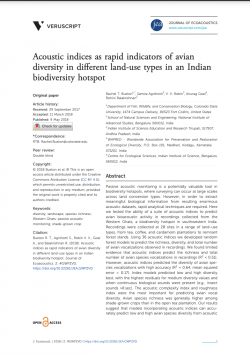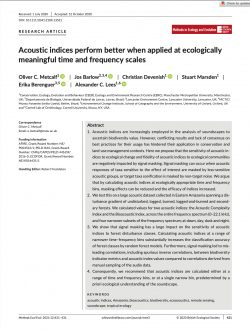Acoustic indices as rapid indicators of avian diversity in different land-use types in an Indian biodiversity hotspot

Type
Journal
Authors
Buxton ( Rachel T. Buxton )
Agnihotri ( Samira Agnihotri )
Robin ( V. V. Robin )
Goel ( Anurag Goel )
Balakrishnan ( Rohini Balakrishnan )
Category
Article
[ Browse Items ]
Publication Year
2018
Publisher
Journal of Ecoacoustics, United States
URL
[ private ]
Volume
2 (1)
Abstract
Passive acoustic monitoring is a potentially valuable tool in biodiversity hotspots, where surveying can occur at large scales across land conversion types. However, in order to extract meaningful biological information from resulting enormous acoustic datasets, rapid analytical techniques are required. Here we tested the ability of a suite of acoustic indices to predict avian bioacoustic activity in recordings collected from the Western Ghats, a biodiversity hotspot in southwestern India. Recordings were collected at 28 sites in a range of land-use types, from tea, coffee, and cardamom plantations to remnant forest stands. Using 36 acoustic indices we developed random forest models to predict the richness, diversity, and total number of avian vocalizations observed in recordings. We found limited evidence that acoustic indices predict the richness and total number of avian species vocalizations in recordings (R2 < 0.51). However, acoustic indices predicted the diversity of avian species vocalizations with high accuracy (R2 = 0.64, mean squared error = 0.17). Index models predicted low and high diversity best, with the highest residuals for medium diversity values and when continuous biological sounds were present (e.g., insect sounds >8 sec). The acoustic complexity index and roughness index were the most important for predicting avian vocal diversity. Avian species richness was generally higher among shade-grown crops than in the open tea plantation. Our results suggest that models incorporating acoustic indices can accurately predict low and high avian species diversity from acoustic recordings. Thus, ecoacoustics could be an important contributor to biodiversity monitoring across landscapes like the Western Ghats, which are a complex mosaic of different land-use types and face continued changes in the future.
Description
https://dx.doi.org/10.22261/jea.gwpzvd
Number of Copies
1
| Library | Accession No | Call No | Copy No | Edition | Location | Availability |
|---|---|---|---|---|---|---|
| Main | 132 | 1 | Yes |



